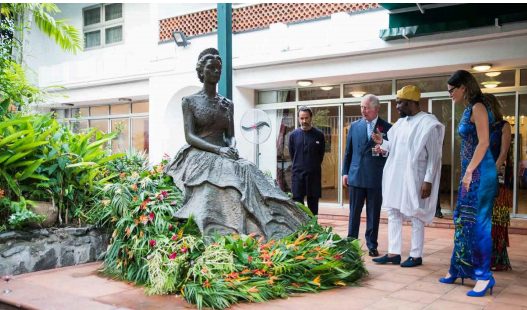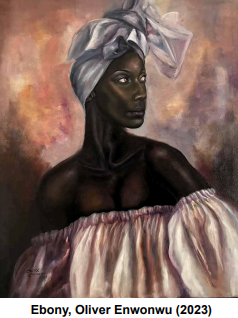
As an observer deeply embedded in the global art discourse, I find myself compelled to explore the profound resonance of Oliver Enwonwu’s contributions to Nigerian art within the context of his father’s esteemed legacy.
Oliver’s journey, intricately intertwined with heritage and innovation, offers a poignant reflection on the complexities of Nigerian artistic identity, as well as its ongoing dialogue with historical legacies and contemporary challenges.
Oliver’s trajectory as an artist, curator, and author reflects an interesting interplay between tradition, innovation, heritage, and modernity, especially within the context of the esteemed modernist artist Ben Enwonwu, his father. By demonstrating the artistic genius of both father and son, the works in Continued Legacy open a dialogue on the evolution of Nigeria’s history in the arts throughout the last seven decades.

One of the featured Ben Enwonwu pieces is “Blue Boy”, shown above. Created in 1959, this painting encapsulates the essence of Nigerian culture and identity through its striking portrayal of a young Nigerian boy. Enwonwu’s use of white and vibrant blue as the highlights of the subject’s skin, and the subtle blending of earthy tones in the painting’s background create a captivating contrast that draws the viewer’s attention. The boy’s stoic expression and direct gaze convey a sense of resilience and agility, reflecting the artist’s exploration of themes such as individuality and inner strength within the context of post-colonial Nigeria.
Through “Blue Boy,” Enwonwu not only celebrates the beauty of his homeland but also engages the nuances of Nigerian identity in the wake of colonialism. The painting serves as an important reminder of the cultural richness and diversity that define Nigeria. Enwonwu’s masterful brushwork and attention to detail elevate “Blue Boy” beyond mere representation, transforming it into a powerful symbol of pride and self-affirmation for generations of Nigerians.
Furthermore, as one of Enwonwu’s most unique works, “Blue Boy” holds significant historical and artistic importance within the context of Nigerian art. Through his innovative approach to painting and his commitment to representing the spirit of his homeland, Enwonwu paved the way for future generations of Nigerian artists to assert their own cultural identities on the global stage.
“Blue Boy” stands as a testament to Ben Enwonwu’s enduring legacy as a pioneer of Nigerian art and a visionary cultural ambassador.

Oliver’s leading lady for this exhibition is portrayed in “Ebony”, a masterpiece completed in 2023. His attention to detail captures the essence of her character, from the graceful curve of her cheekbones to the intensity of her gaze. Each brushstroke serves to emphasize the inherent dignity and power embodied by the subject, elevating the black female form to a place of reverence—an admiration shared by both Enwonwu and his father.
Those familiar with the Nigerian artistic canon might compare the figure in “Ebony” with the late Enwonwu’s celebrated “Tutu,” a painting about the celebrated Nigerian Princess Adetutu Ademiluyi. His 1973 portrait of the Yoruba royal is regarded as a prominent symbol of Nigerian culture, sometimes referred to as “Nigeria’s Mona Lisa.” In both “Ebony” and “Tutu,” the black female subject emerges as a symbol of grace, and strength, representing indigenous Nigerian aesthetics rooted in the intellectual and spiritual consciousness of pre-colonial West Africa. By celebrating the inherent beauty of ebony skin tones and embracing the multifaceted nature of blackness, these portraitures celebrate the magnificence of the Nigerian feminine spirit.
In an earlier portrayal of a regal female figure, Ben Enwonwu was commissioned in 1956 by Queen Elizabeth II to create a statue in her likeness in commemoration of the royal’s visit to Nigeria that year. It was completed in London and unveiled there in November 1957. Enwonwu’s task was to encapsulate the regal presence of the Queen in bronze, capturing her likeness while incorporating indigenous sculpting techniques and Enwonwu’s own experiments with the three-dimensional medium.

King Charles with Oliver Enwonwu visiting Queen Elizabeth II statue in 2018
“Ebony” is a captivating exploration of identity and cultural heritage. Enwonwu creates a visually arresting composition that invites viewers to contemplate the complexities of race, beauty, and representation. The title itself, “Ebony,” suggests a deep reverence for the richness and depth of blackness, while also evoking notions of strength and resilience.
At the heart of “Ebony” lies a profound interrogation of societal norms and perceptions surrounding blackness. Enwonwu’s meticulous attention to detail and his skillful manipulation of form and texture imbue the piece with a sense of dynamism and depth, drawing viewers into a dialogue about the inherent beauty and diversity within the black experience.
Furthermore, “Ebony” serves as a powerful testament to Enwonwu’s commitment to challenging stereotypes and reshaping the narrative surrounding black identity. By celebrating the inherent beauty of ebony skin tones and embracing the multifaceted nature of blackness, Enwonwu invites viewers to consider their own preconceived notions and biases, fostering a greater appreciation for the richness of the African experience.
Moreover, Enwonwu’s portrayal of the black female subjects in general transcends mere representation, serving as a reflection of the artist’s cultural heritage and identity. By celebrating the beauty and majesty of the black female form, Enwonwu affirms the inherent worth and value of black women everywhere, reclaiming their place at the center of the artistic narrative.
While Ben Enwonwu is celebrated for his groundbreaking works that merged indigenous African aesthetics with European artistic techniques, Oliver’s artistic style demonstrates a departure towards more contemporary themes.
Oliver’s art often delves into personal narratives and explorations of identity, memory, and social justice, reflecting his own experiences and observations of the world around him. Unlike his father’s focus on iconic figures and historical events, Oliver’s work tends to be more introspective and reflective of his generation’s concerns and perspectives.
2023’s “Duality of Time” represents a contemporary interpretation of Nigerian symbols that resonates with Oliver’s new direction in using art to document the evolving Nigerian consciousness. In a lot of his contemporary works, he uses the mask to represent specific rituals within the Nigerian traditional African landscape. At the center of this figure is, again, the adoration of the Nigerian woman and the role she plays in the development and growth of Nigerian society. In the same way that Tiziano portrays the three stages of life in “Allegory of Prudence”, Enwonwu represents these figures with a young girl, an adult woman, and an experienced elder. The figure also brings to mind traditional notions of spirituality that can be learned from the animal kingdom and nature in general.

The painting portrays two human heads and a mask above a dog, a lion and eagle. According to Enwonwu, the animal heads represent “the three elements of time: the past, present and future, with the dog symbolizing the past, the lion representing the present and the eagle, the future.”
This duality of time is a reflection of Oliver’s deep interest in Nigerian cultural imagery, and can as well be said to reflect stages of his development as an influential figure in the Nigerian art scene not just as an artist, but as a facilitator of cultural discussion and preservation.
Inspired by his father’s legacy, Oliver embarks on a quest to carve his own artistic niche while honoring the enduring heritage of Ben Enwonwu. His works, infused with themes of cultural identity, African spirituality, ancestral epistemology, memory, and social justice, resonate with echoes of his father’s artistic vision, forging new connections between past and present within the Nigerian art landscape. As I observe, Oliver’s artistic endeavors serve as a testament to the enduring legacy of Ben Enwonwu, illuminating the cultural richness and complexity of Nigerian society.
As the custodian of his father’s artistic estate, Oliver assumes the dual role of preserver and innovator, seeking to honor Ben Enwonwu’s legacy while pushing the boundaries of Nigerian art. Through initiatives such as The Ben Enwonwu Foundation, Oliver endeavors to promote Nigerian art and cultural heritage, fostering dialogue and collaboration within the artistic community. His efforts reflect a deep-seated commitment to advancing his father’s legacy and nurturing the next generation of Nigerian artists.
Oliver Enwonwu’s contributions to the Nigerian art sector represent an insightful engagement with his father’s legacy and the broader socio-cultural landscape of Nigeria. His artistic vision and unwavering dedication navigate the diversity of identities, histories, and traditions, forging new pathways of artistic expression while honoring the enduring heritage of Ben Enwonwu.
Oliver Enwonwu’s artistic endeavors serve as a testament to the enduring legacy of Ben Enwonwu and the rich cultural heritage of Nigeria. Through his exploration of themes deeply rooted in Nigerian identity and history, Oliver forges a path that honors tradition while embracing innovation, shaping the trajectory of Nigerian art for generations to come. Though there are differences in their approach and subject matter, both artists’ enduring contributions continue to shape the Nigerian art canon today, leaving a trail for the current and upcoming generations of the country’s artists to build upon, including Oliver himself.
About Ludlow Bailey
Ludlow Bailey is a curator of culture as art, art broker, writer, and art advisor. He is extremely passionate about contemporary global African diaspora art and culture. Currently, he is the Managing Director of Contemporary African Diaspora Art (CADA), a multi-media platform designed to present and promote the visual culture of the African diaspora and provide art advisory Services. Mr. Bailey has traveled extensively throughout the African diaspora and is considered one of the leading experts on Contemporary African Diaspora Art. He resides in Miami, Florida.
Email: Ludlowebailey@gmail.com
IG: @ludlowebailey/@cadaonline
*****Republished from cada.us with permission from Ludlow Bailey.
